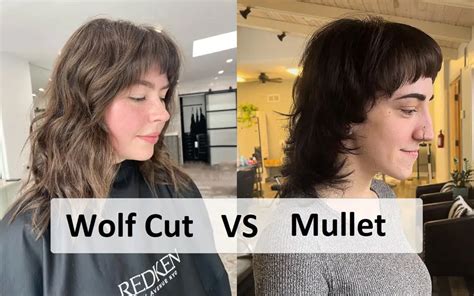Introduction
The world of hairstyles is constantly evolving, with new trends emerging and old favorites making a comeback. Two recent additions to the hair trend scene that have sparked much buzz are the wolf cut and the mullet. Both styles feature shaggy layers and edgy vibes, but they also have their unique characteristics and appeal. In this article, we will dive into the details of each hairstyle, compare their similarities and differences, and explore why they have captured the attention of fashion-forward individuals.

The Wolf Cut
The wolf cut, as the name suggests, is a wild and untamed hairstyle that mimics the appearance of a wolf’s mane. It is characterized by long, shaggy layers that are cut in a V-shape, creating a voluminous and textured look. The top layer typically has shorter, choppy sections, while the lower layers are longer and flowier. Due to its layered nature, the wolf cut is often styled with a lot of texture and movement, giving it a carefree and androgynous appeal.
The Mullet
The mullet, on the other hand, has a long and controversial history. It is typically associated with the 1980s and is characterized by short hair on the sides and top, with long hair at the back. The mullet has gone through several transformations over the years, and modern interpretations often feature variations on the classic style, such as adding layers or fading the sides. Despite its reputation as an outdated hairstyle, the mullet has regained popularity in recent years, becoming a symbol of rebellion and individuality.
Similarities between Wolf Cut and Mullet
Despite their differences, the wolf cut and mullet share some common elements that contribute to their unique appeal:
- Shaggy Layers: Both hairstyles feature shaggy layers that create texture and volume.
- Edgy Vibes: Both the wolf cut and mullet exude an edgy and unconventional aesthetic.
- Androgynous Appeal: Both styles can be adapted to suit both masculine and feminine aesthetics.
Differences between Wolf Cut and Mullet
While they share some characteristics, the wolf cut and mullet have several distinct differences that set them apart:
- Placement of Layers: The wolf cut features V-shaped layers throughout, while the mullet has shorter layers on the sides and top and longer layers at the back.
- Volume and Texture: The wolf cut is typically more voluminous and textured than the mullet due to the presence of layers throughout the entire head.
- Styling: The wolf cut is often styled with more texture and movement, while the mullet can be styled in various ways, depending on the desired look.
Why Wolf Cut and Mullet Matter
The wolf cut and mullet have become popular for several reasons:
- Fashion Forward: Both styles reflect the latest trends in fashion and are associated with individuality and rebellion.
- Versatility: The wolf cut and mullet can be adapted to suit both short and long hair lengths, making them versatile options for different hair types.
- Low Maintenance: Both styles require minimal maintenance, making them ideal for busy individuals who want a stylish but effortless look.
Tips and Tricks for Wolf Cut and Mullet
To achieve the perfect wolf cut or mullet, consider the following tips:
- Consider Hair Type: The wolf cut and mullet can be adapted to different hair types, but it’s important to consider your own hair texture and density when selecting a style.
- Find an Experienced Stylist: A skilled stylist can customize the wolf cut or mullet to suit your face shape and hair type.
- Experiment with Styling: With both wolf cuts and mullets, there are endless styling possibilities. Experiment with volume, texture, and accessories to create your own unique look.
Tables for Comparison
To provide a clear overview of the differences and similarities between the wolf cut and mullet, here are four useful tables:
| Feature | Wolf Cut | Mullet |
|---|---|---|
| Layer Placement | V-shaped layers throughout | Shorter layers on sides and top, longer layers at back |
| Volume and Texture | High volume, high texture | Moderate volume, moderate texture |
| Styling | Emphasis on texture and movement | Variety of styling options |
| Maintenance | Minimal maintenance | Low maintenance |
| Wolf Cut | Mullet |
|---|---|
| Length | Short to long |
| Layers | Multiple layers throughout |
| Volume | High |
| Texture | High |
| Styling | Messy, textured |
| Maintenance | Low |
| Feature | Wolf Cut | Mullet |
|---|---|---|
| Origin | 2020s | 1980s |
| Popularized By | Gen-Z | Gen-X |
| Associated With | Individuality, rebellion | Rebellion, nostalgia |
| Versatility | Suitable for various hair types | Suitable for various hair types |
| Maintenance | Minimal | Minimal |
| Wolf Cut | Mullet |
|---|---|
| Length | Short to long |
| Layers | Multiple layers throughout |
| Volume | High |
| Texture | High |
| Styling | Messy, textured |
| Maintenance | Low |
| Versatility | Suitable for various hair types |
| Appearance | Wild, untamed |
Conclusion
The wolf cut and mullet have taken the hairstyling world by storm, offering unique and edgy options for individuals looking to express their individuality and embrace the latest trends. With their shared characteristics of shaggy layers and rebellious vibes, these styles are well-suited for both masculine and feminine aesthetics. While the wolf cut features V-shaped layers throughout the hair for maximum volume and texture, the mullet maintains shorter layers on the sides and top with longer layers at the back. Both hairstyles require minimal maintenance, making them attractive options for busy individuals. Ultimately, the choice between a wolf cut and a mullet depends on personal preference, hair type, and desired level of volume and texture.
